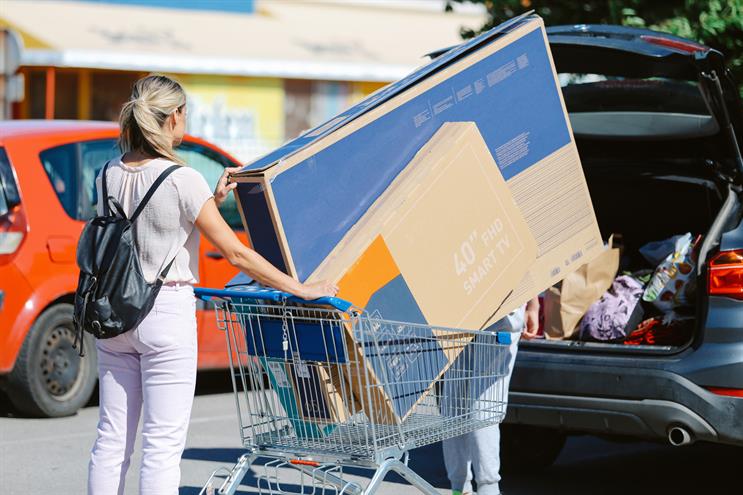
While the demand for online shopping continues to grow, new research shows that UK drivers prefer to visit retailers in person.
The Ipsos report, “Waze Knows: The drivers of today and what’s fuelling their purchasing decisions”, found that UK drivers prefer in-person shopping to online shopping in almost all retail categories. Not only that, but two-thirds of UK drivers regularly use their cars to visit the high street or shopping centre. Simply, UK drivers love to shop.
Waze, the free driving app that uses crowd-sourced data for its maps and carries advertising, knows drivers. It knows the behaviours of drivers; it knows if a driver is headed to the shops rather than, say, the cinema. Unsurprisingly, this is rather good news for brands looking to reach on-the-go consumers.
“A huge priority for our media strategy at M&S is driving footfall into our stores, and we recognise that reaching people on the go is an extremely effective tool to achieve this,” says Katy Allison, media strategy manager at Marks & Spencer.
“Platforms such as Waze offer us unique navigation inventory and valuable intent signals about where consumers are going. These signals coupled with the time of day, type of trip, and even weather conditions enable us to better understand consumers' mindsets and serve real-time contextual messages during their journeys.”
So how do brands take advantage, not only all year round, but during big retail moments such as Black Friday?
How to drive footfall
“Simply, Waze is used for driving footfall to physical stores,” says Ruairidh Roberts, Waze’s UK country manager. “We know we can increase footfall to a business, even if they're not the nearest store to a driver. So if you appear on our map, and your competitor doesn't, we know we're driving footfall to your business. We can do that for businesses where there isn’t a great deal of loyalty, such as fuel and convenience stores.
“We can also go one better, and work with brands. We know if a driver is heading to a city centre, we know if they're going to a particular area where there's a retail outlet, because we have that geographical knowledge.”
So if you’re a marketeer at, say, a gravy brand, you might want your product to be seen on a Sunday morning when people are heading to the supermarket with delicious roasts on their minds. Waze provides that contextual understanding of the time of day, and where someone is heading. For brands, that creates the special sauce (or gravy, in this instance).
It’s not only for brands that want people heading to their stores, but also for brands wanting to capture people on their commute home. For example, Waze works with TV streaming companies and food delivery brands to help them reach drivers on their way home, to promote a new TV series, or tempting food options.
“We're brilliant for location-based retailers, but non-location-based brands can also capitalise on these contextual moments really effectively,” says Roberts.
This creates massive opportunities for brands. Using pins, search, and takeovers, Waze Ads reach target audiences closer to the point of decision-making. The result? According to a study by Forrester Consulting, businesses that deploy Waze Ads see an immediate return on ad spend of 17.1% and an 8% increase in business to stores.
Being present
“The success of Waze has come from allowing advertisers to be present, contextually and locally,” says Roberts. “And understanding when people are likely to respond to your product or proposition.”
Part of that understanding comes from knowing drivers, inside out. The Waze Knows report found that the majority of UK drivers – 78% – always pre-plan their shopping destination before driving. On the other hand, many drivers make their decision on impulse: 20% said the last time they bought clothes after travelling by car, they did so spontaneously. Among Waze UK users, that figure is even higher, at 28%.
This represents good news for retail brands looking to reach drivers on the move. The even better news is that the research indicates that drivers are receptive to advertising while driving, with almost a quarter (24%) of drivers saying they would change their choice of retailer while driving if they saw or heard an ad for another one that interested them.
Leveraging Black Friday
While Waze works to drive footfall and awareness all year round, it can also be leveraged around big retail moments.
UK drivers are also deal hunters, and there is no greater hunting to be done than around Black Friday. Almost half (48%) of the drivers surveyed agreed that they would drive to a discount store to buy a product, even if there were stores selling similar products closer to their homes. And 59% of drivers agreed they would be more likely to drive to a retailer if they knew it had a sale.
“We know the high streets go nuts around Black Friday,” says Roberts. “So we know intrinsically that people will be swayed in those moments. But for advertisers to get cut-through out of home is hard on radio because everyone's doing it, and there are offers coming out of your ears. With Waze, we show one ad at a time. It's really organic, and it feels very natural. It offers good cut-through in a highly cluttered moment with the relevance of knowing somebody is heading in your direction.
“All we need is the location of where your sale is and what your offer is. It’s really simple. That drives footfall, it drives an increased basket value, and it drives a much higher return on ad spend.”


